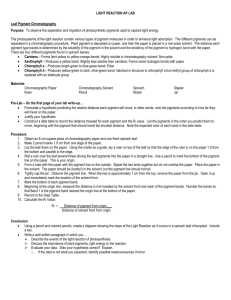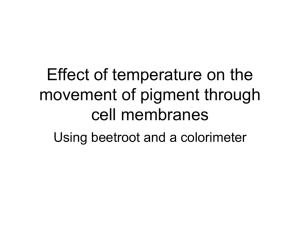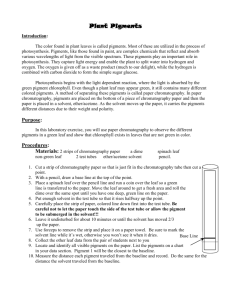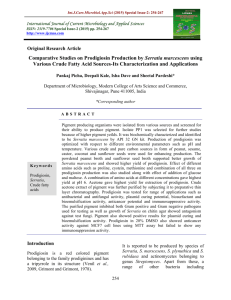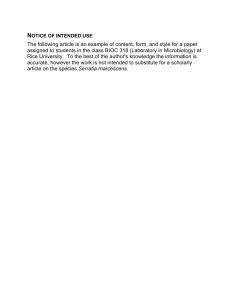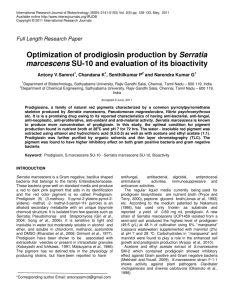Transmission Wavenumber (1/cm)
advertisement
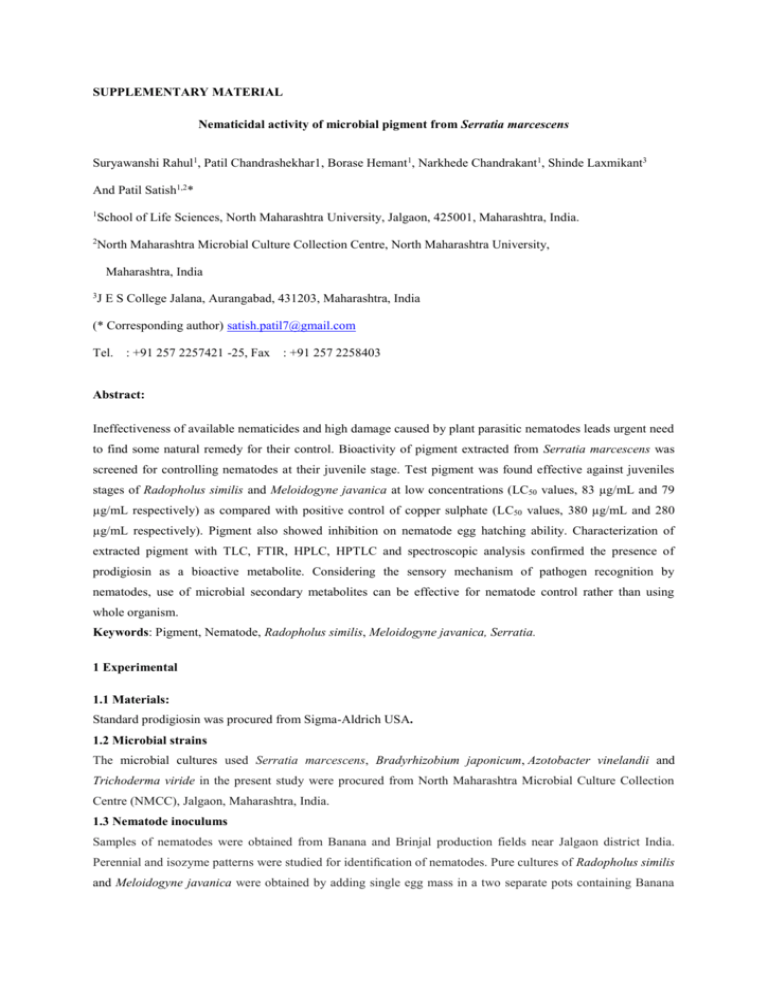
SUPPLEMENTARY MATERIAL Nematicidal activity of microbial pigment from Serratia marcescens Suryawanshi Rahul1, Patil Chandrashekhar1, Borase Hemant1, Narkhede Chandrakant1, Shinde Laxmikant3 And Patil Satish1,2* 1 School of Life Sciences, North Maharashtra University, Jalgaon, 425001, Maharashtra, India. 2 North Maharashtra Microbial Culture Collection Centre, North Maharashtra University, Maharashtra, India 3 J E S College Jalana, Aurangabad, 431203, Maharashtra, India (* Corresponding author) satish.patil7@gmail.com Tel. : +91 257 2257421 -25, Fax : +91 257 2258403 Abstract: Ineffectiveness of available nematicides and high damage caused by plant parasitic nematodes leads urgent need to find some natural remedy for their control. Bioactivity of pigment extracted from Serratia marcescens was screened for controlling nematodes at their juvenile stage. Test pigment was found effective against juveniles stages of Radopholus similis and Meloidogyne javanica at low concentrations (LC50 values, 83 µg/mL and 79 µg/mL respectively) as compared with positive control of copper sulphate (LC50 values, 380 µg/mL and 280 µg/mL respectively). Pigment also showed inhibition on nematode egg hatching ability. Characterization of extracted pigment with TLC, FTIR, HPLC, HPTLC and spectroscopic analysis confirmed the presence of prodigiosin as a bioactive metabolite. Considering the sensory mechanism of pathogen recognition by nematodes, use of microbial secondary metabolites can be effective for nematode control rather than using whole organism. Keywords: Pigment, Nematode, Radopholus similis, Meloidogyne javanica, Serratia. 1 Experimental 1.1 Materials: Standard prodigiosin was procured from Sigma-Aldrich USA. 1.2 Microbial strains The microbial cultures used Serratia marcescens, Bradyrhizobium japonicum, Azotobacter vinelandii and Trichoderma viride in the present study were procured from North Maharashtra Microbial Culture Collection Centre (NMCC), Jalgaon, Maharashtra, India. 1.3 Nematode inoculums Samples of nematodes were obtained from Banana and Brinjal production fields near Jalgaon district India. Perennial and isozyme patterns were studied for identification of nematodes. Pure cultures of Radopholus similis and Meloidogyne javanica were obtained by adding single egg mass in a two separate pots containing Banana and Brinjal plant cultivated in sterilized soil with 70% relative humidity and 25 0C temperature for around 2 months. Culture was further multiplied by inoculation in new pots containing Banana and Brinjal seedlings. Egg masses were extracted using 1% NaClO, solution whereas juveniles were obtained by soil near the rhizosphere of plants and both were immediately used for bioassays (Hussey and Barker 1973). 1.4 Production of pigment: Pigment was produced using peptone glycerol broth. 24 h old culture of Serratia marcescens was used for inoculation purpose and was kept on shaker at 30°C ±2 for two days. 1.5 Extraction and quantification of pigment: Pigmented cultures centrifuged at 7000 x g for 10 min to get cell mass. Cell pellet was dispensed in acidified methanol and again centrifuged. This way the pigment was recovered by acidified methanol. The crude extract was purified by preparative TLC in (Hi-250F) silica plates using butanol: hexane (2:1) as a solvent system. Pigment from the separated spot was recovered, dissolved in chloroform and dried by evaporation. Pigment was quantified on a dry weight basis. Pigment was further dissolved in pure DMSO for a concentration of 5 mg/mL and was used for the assay. 1.6 Confirmation of pigment: TLC purified pigment was subjected to UV visible spectrophotometry in the range 700–350 nm in DMSO. The pigment recovered from TLC plates further analyzed by high-performance liquid chromatography (HPLC) Shimadzu instrument (Kyoto, Japan). HPLC was performed using Nucleosil C18 column. It was eluted using a mixture of methanol: water (9:1). Flow rate was kept as 1mL/min. The elution was monitored both using diodearray UV detector. Detection wavelength was 536nm. The Pigment was further characterized using Fourier transform infrared spectrophotometer (Testscan Shimadzu FTIR 8400, Japan). Dried pigment was mixed with KBr powder and pressed into pellet for FTIR spectroscopy, frequency range 4000-400 cm-1. 1.7 In vitro nematicidal activity Stock solution of pigment (10 mg/mL) was used to prepare different concentrations of prodigiosin. The test concentrations (500, 250, 125, 62.5 and 31 µg/mL) of prodigiosin were made by adding distilled water, vehicle concentration of DMSO with distilled water was kept as a negative control. After that, nematode suspension containing 100 juveniles was added into the wells and kept standing at 24 ºC in the dark. The experiment was carried out in triplicates. Dead and alive nematodes were counted after 12, 24 and 36 h to evaluate the percent mortality. This procedure was repeated 3 times. Juveniles were defined as dead if their body was straight and they did not move, even after mechanical stimulation (Choi et al. 2007). Possible recovery effect was evaluated by transferring the dead nematodes to fresh distilled water and observed for any movement till 24 h. Similarly unhatched eggs were observed for each concentration after 12, 24, and 36 h of incubation. Counting for both eggs and larvae was done under inverted microscope. 1.8 Toxicity assay of pigment Concentration of pigment responsible for 90% mortality of nematode species was exposed to liquid culture of all the three microorganisms (Bradyrhizobium japonicum, Azotobacter vinelandii and Trichoderma viride) and kept for incubation at 37 °C for 24 h for bacteria and 72 h for fungi. 1.9 Statistical analysis Percent mortality was calculated using following formula. 𝑃𝑒𝑟𝑐𝑒𝑛𝑡 𝑀𝑜𝑟𝑡𝑎𝑙𝑖𝑡𝑦 = 100 × 1 − 𝑇𝑒𝑠𝑡 𝐶𝑜𝑛𝑡𝑟𝑜𝑙 The lethal concentrations at 50% and 90% (LC50, LC90) were calculated by regression equation with the data showing 95% confidence intervals. 2 Results: Figure S1: Thin layer chromatography of standard prodigiosin (A) and pigment extract (B). [1] Plate view in visible light, [2] plate view in UV light. 535nm Figure S2: Absorption spectrum of pigment from Serratia marcescens. Figure S3: HPLC of Pigment from Serratia marcescens Figure S4: FTIR spectrum of pigment from Serratia marcescens. Figure S5: HPTLC analysis of pigment from Serratia marcescens.


